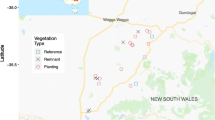Abstract
Nest boxes are commonly erected in managed landscapes such as backyards, golf courses and parks, attracting cavity-nesting birds to habitats they would not otherwise occupy. Although studies have shown that habitat around natural nests influences postfledging survival, this relationship has not been examined for artificial nest cavities, which humans may site at inappropriate locations. In Williamsburg, Virginia, we compared vegetation surrounding nest boxes which produced eastern bluebird fledglings that were predated by hawks within 10 days of leaving the nest to vegetation surrounding nest boxes producing surviving fledglings. We found a significant difference between PC scores for forest denseness around nest boxes that produced surviving versus predated fledglings; fledglings that survived tended to come from nest boxes with high forest and canopy cover, close trees and little grass.

Similar content being viewed by others
References
Anders AD, Dearborn DC, Faaborg J, Thompson FR III (1997) Juvenile survival in a population of neotropical migrant birds. Conserv Biol 11:698–707
Anders AD, Faaborg J, Thompson FR III (1998) Postfledgling dispersal, habitat use, and home-range size of juvenile wood thrushes. Auk 115:349–358
Berkeley LI, McCarty JP, Wolfenbarger LL (2007) Postfledging survival and movements in dickcissels (Spiza americana): implications for habitat management and conservation. Auk 124:396–409
Both C, Bouwhuis S, Lessels CM, Visser ME (2006) Climate change and population declines in a long-distance migratory bird. Nature 441:81–83
Caccamise DF, Hedin RS (1985) An aerodynamic basis for selecting transmitter loads in birds. Wilson Bull 97:306–318
Cohen EB, Lindell CA (2004) Survival, habitat use, and movements of fledgling white-throated robins (Turdus assimilis) in a Costa Rican agricultural landscape. Auk 121:404–414
Cornell KL, Kight CR, Burdge RB, Gunderson AR, Hubbard JK, Jackson AK, LeClerc JE, Pitts ML, Swaddle JP, Cristol DA (2011) Reproductive success of eastern bluebirds on suburban golf courses. Auk 128:577–586
Gowaty PA, Plissner JH (1998) Eastern bluebird (Sialia sialis). In: Poole A, Gill F (eds) The birds of North America. American Ornithologists’ Union, Philadelphia, No. 381
Jackson JA, Tate J Jr (1974) An analysis of nest box use by purple martins, house sparrows, and starlings in eastern North America. Wilson Bull 86:435–449
Jackson AK, Froneberger JP, Cristol DA (2011) Postfledging survival of eastern bluebirds in an urbanized landscape. J Wildl Manag 75:1082–1093
Jennings SB, Brown ND, Sheil D (1999) Assessing forest canopies and understorey illumination: canopy closure, canopy cover and other methods. Forestry 72:59–74
Johansson T (1985) Estimating canopy density by the vertical tube method. For Ecol Manag 11:139–144
King DI, Degraaf RM, Smith ML, Buonaccorsi JP (2006) Habitat selection and habitat-specific survival of fledgling ovenbirds (Seiurus aurocapilla). J Zool 269:414–421
LeClerc JE, Che JPK, Swaddle JP, Cristol DA (2005) Reproductive success and developmental stability of eastern bluebirds on golf courses: evidence that golf courses can be productive. Wildl Soc B 33:483–493
Marshall MR, DeCecco JA, Williams AB, Gale GA, Cooper RJ (2003) Use of regenerating clearcuts by late-successional bird species and their young during the post-fledging period. For Ecol Manag 183:127–135
Mitchell K (2007) Quantitative analysis by the point-centered quarter method. Hobart and William Smith Colleges online http://arxiv.org/pdf/1010.3303.pdf
Moore LC, Stutchbury BJM, Burke DM, Elliott KA (2010) Effects of forest management on postfledging survival of rose-breasted grosbeaks (Pheucticus ludovicianus). Auk 127:185–194
Naef-Daenzer B, Widmer F, Nuber M (2001) Differential post-fledging survival of great and coal tits in relation to their condition and fledging date. J Anim Ecol 70:730–738
Newton I (1994) The role of nest sites in limiting the numbers of hole-nesting birds: a review. Biol Conserv 70:265–276
Rappole JH, Tipton AR (1991) New harness design for attachment of radio transmitters to small passerines. J Field Ornithol 62:335–337
Ryder TB, Reitsma R, Evans B, Mara P (2010) Quantifying avian nest survival along an urbanization gradient using citizen- and scientist-generated data. Ecol Appl 20:419–426
Schmidt KA, Rush SA, Ostfeld RS (2008) Wood thrush nest success and post-fledging survival across a temporal pulse of small mammal abundance in an oak forest. J Anim Ecol 77:830–837
Stanback MT, Seifert ML (2005) A comparison of eastern bluebird reproductive parameters in golf and rural habitats. Wildl Soc B 33:471–482
Whittaker KA, Marzluff JM (2009) Species-specific survival and relative habitat use in an urban landscape during the postfledging period. Auk 126:288–299
Yackel Adams AA, Skagen SK, Savidge JA (2006) Modeling post-fledging survival of lark buntings in response to ecological and biological factors. Ecology 87:178–188
Acknowledgments
Our research was funded by a National Fish and Wildlife Foundation Wildlife Links Grant (funded by the United States Golf Association), and J. P. F. was supported by a National Science Foundation UBM grant (0436318). Funding for telemetry equipment came from the Association of Field Ornithologists E. Alexander Bergstrom Memorial Award, Coastal Virginia Wildlife Observatory Joy Archer Student Research Grant, Williamsburg Bird Club Student Research Grant, Sigma Xi Grants-in-Aid of Research, the Department of Biology and a School of Arts and Sciences Graduate Research Grant from the College of William and Mary. We are grateful to all of the golf courses and parks administrators for permitting us to use their property, along with K.C. Duerr and C.W. Ramos for helpful comments on this manuscript.
Author information
Authors and Affiliations
Corresponding author
Rights and permissions
About this article
Cite this article
Jackson, A.K., Froneberger, J.P. & Cristol, D.A. Habitat near nest boxes correlated with fate of eastern bluebird fledglings in an urban landscape. Urban Ecosyst 16, 367–376 (2013). https://doi.org/10.1007/s11252-012-0265-0
Published:
Issue Date:
DOI: https://doi.org/10.1007/s11252-012-0265-0




